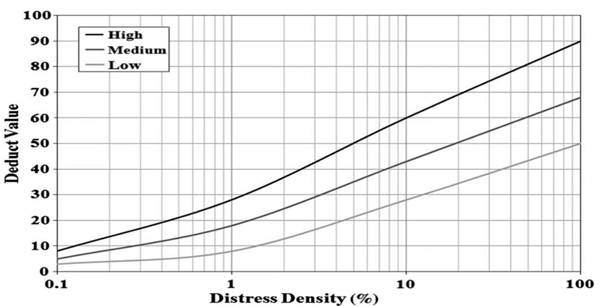The maintenance of pavement is essential for ensuring traffic safety and providing a smooth riding experience. To keep all paved roads in good structural condition, a Pavement Management System (PMS) is an effective solution. An effective PMS should include performance models, a centralized database, and tools for generating reports and conducting analyses.
Several techniques are available to assess the quality of pavement, including the International Roughness Index (IRI), Pavement Condition Index (PCI), Present Serviceability Rating (PSR), Pavement Quality Index (PQI), Pavement Distress Index (PDI), Pavement Condition Rating (PCR), and Surface Distress Index (SDI). Among these, the PCI is the most widely used method for evaluating pavement conditions. It was developed by the U.S. Army Corps of Engineers to assess changes in road network systems.
In recent years, transportation agencies worldwide have utilized PCI data to guide decisions regarding the construction, repair, and maintenance of airfields, roads, and parking lots. Their studies relied on visual surveys—using imagery or field inspections—to identify the types, severity, and quantity of pavement distresses. The PCI method effectively evaluates a structure’s integrity, serves as a reliable indicator of current and future performance, and does not require structural testing, skid resistance measurements, or roughness evaluations.
The PCI is a numerical rating that ranges from 0 to 100, where 0 represents the worst possible condition, and 100 indicates the best. Consequently, a team of researchers conducted a study to develop Multi-Linear Regression (MLR) and Artificial Neural Network (ANN) models based on PCI, assessing their performance for pavement condition evaluation.
Numerous researchers have adopted Pavement Condition Index (PCI) in their studies, highlighting a transition from traditional linear and non-linear regression methods to more sophisticated computational techniques. This shift includes the use of Support Vector Machines (SVM), Artificial Neural Networks (ANN), fuzzy logic, and Gaussian Process Regression (GPR) to assess variables such as crack investigation and fatigue distress.
A variety of methodologies have been implemented to model pavement conditions and forecast costs associated with construction projects. Notably, Artificial Neural Networks have demonstrated significant scalability and versatility, making them particularly effective for analyzing complex, non-traditional problems. The architecture of ANN networks comprises an input layer, one or more hidden layers, and an output layer, where the number of hidden neurons plays a crucial role in determining model accuracy.
In addition, several regression models have been developed, yielding favourable outcomes for various projects related to pavement distress, taking into account traffic and other influencing factors. Collectively, these advancements indicate a substantial enhancement in predictive capabilities through the application of modern computational techniques.
The study utilized a dataset comprising 333 samples collected from the Long-Term Performance Pavement (LTPP) program, initiated by the Strategic Highway Research Program (SHRP) in 1987. The dataset features ten key input parameters: age (in years), rutting (in mm), fatigue cracking (in m²), block cracking (in m²), longitudinal cracking (in m²), transverse cracking (in m²), patching (in m²), and the number of potholes. These parameters were analyzed to predict the Pavement Condition Index (PCI) under both wet and wet no-freeze conditions.
To calculate the PCI for flexible pavement systems, the method involves initially assessing the intensity and extent of each type of distress. Subsequently, distress density is computed, and points are deducted from standard deduct value curves specific to each distress category. The final PCI score is determined by calculating the Total Deduct Value (TDV) and applying the Corrected Deduct Value (CDV).

Two modelling approaches were developed for PCI prediction: Multiple Linear Regression (MLR) and Artificial Neural Networks (ANN). For the MLR model, the dataset was split into 80% for training and 20% for testing, with analysis conducted using the IBM SPSS software. In contrast, the ANN model utilized a 70% training and 30% testing split. The optimal neural network model was derived by experimenting with various network structures and training algorithms, specifically employing a backpropagation learning approach with the Levenberg-Marquardt algorithm in a MATLAB environment. The architecture of the best-performing model consisted of 10 neurons in the input layer, 14 neurons in the first hidden layer, 10 neurons in the second hidden layer, 10 neurons in the third hidden layer, and a single neuron in the output layer.
The evaluation of the models’ performance was conducted using the coefficient of determination (R²) and the mean absolute error (MAE). The results are summarized as follows:
For the Wet Freeze Region:
– MLR: R² = 86.8; MAE = 5.616
– ANN: R² = 99.8; MAE = 0.44
For the Wet No Freeze Region:
– MLR: R² = 89.4; MAE = 5.79
– ANN: R² = 98.3; MAE = 1.022
These results demonstrate a significant enhancement in predictive accuracy using the Artificial Neural
Network (ANN) model. Specifically, the R² value improved by 13.03% in the wet freeze region and 9.05% in the wet no freeze region. Moreover, the MAE reductions were substantial, with improvements of 92.07% for wet freeze conditions and 82.35% for wet no freeze conditions.
The superior predictive performance of the ANN model can be attributed to its capability to effectively capture the nonlinear relationships among pavement distress parameters. These findings suggest that ANN-based models are more dependable for predicting the Pavement Condition Index (PCI), thereby making them highly suitable for integration into pavement management systems.
The application of ANN models in PCI prediction marks a significant advancement in pavement management. By leveraging soft computing techniques, transportation agencies can improve maintenance planning, reduce costs, and extend pavement lifespan. Future research should explore additional factors such as traffic loads, environmental changes, and material properties to enhance predictive accuracy further.
Reference
Ali, A. A., Heneash, U., Hussein, A., Ali, S. I. A., & Khan, S. (2023). Models Development for Asphalt Pavement Performance Index in Different Climate Regions Using Soft Computing Techniques. Journal of Soft Computing in Civil Engineering, 7(1), 20-42.

